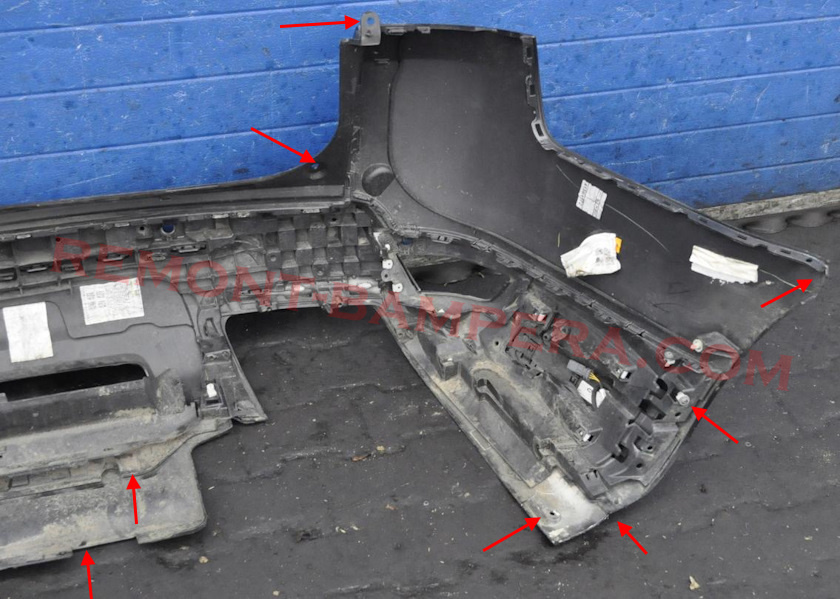The second generation of the Range Rover Sport (model code L494) debuted in 2013, marking a true breakthrough in Land Rover's lineup. This model combined the elegance of the classic Range Rover with dynamic performance and sporty character, winning the hearts of premium SUV enthusiasts.
Redesign and Evolution
Initially produced from 2013 to 2017, the L494 underwent a facelift in 2018 that updated both its exterior and technical features. The exterior changes included:
- A new, narrower, and more stylish radiator grille with chrome accents.
- Modern, aggressive-looking LED headlights and taillights.
- Redesigned bumpers with new lines and additional air intakes for a sportier appearance.
The interior also received upgrades, including digital instrument clusters, premium materials, and the Touch Pro Duo infotainment system with dual touchscreens.
Bumper Plastic Composition
- Polypropylene and ethylene/propylene blend with 15% filler. Marking: PP+E/P+TD15
- Polypropylene with 15% filler. Marking: PP+TD15
How to Remove the Front Bumper
- Open the hood.
- Remove the four clips (unscrew the center screw, then pull out the clip) securing the radiator grille.
- Pull firmly to release the lower part from its clips (pull toward yourself) and remove the grille.
- Unscrew the four screws (inserted top to bottom) securing the upper part of the front bumper.
- From underneath, release the four quick-release fasteners (turn 90° with a flathead screwdriver) and remove the undercover (pulls forward).
- Unscrew the ten screws (inserted bottom to top) securing the lower part.
- On both sides: unscrew two screws, remove three clips, and detach the front half of the wheel arch liner.
- On both sides: unscrew two bolts (inserted bottom to top) securing the bumper to the fender.
- On both sides: inside the wheel well, unscrew the bolt securing the bumper to the headlight.
- On the right side, disconnect the two headlight washer hoses (prepare a container for fluid).
- On the left side, disconnect the main electrical connector.
- Release the clips in the fenders (pull the corners downward).
- With an assistant, remove the bumper by pulling it forward.


How to Remove the Rear Bumper
- Open the trunk.
- Remove the two clips in the trunk opening.
- Near the taillights, remove the covers (pull toward yourself).
- Under the covers, unscrew two screws per side securing the taillights and the upper part of the bumper.
- Release the clips in the fenders and remove the taillights.
- From underneath, unscrew two side screws and two bolts securing the undercover (no need to remove it).
- Fold down the undercover and unscrew two screws (inserted bottom to top).
- In the wheel wells, unscrew one bolt per side securing the bumper corners to the fenders, plus one screw and one clip securing the wheel arch liners.
- Release the clips in the fenders (grip the corner and pull toward yourself).
- With an assistant, remove the bumper by pulling it backward (watch for wiring).
- Disconnect the main electrical connector.


Technical Features and Engines
The Range Rover Sport II offered a wide range of engines, from efficient diesels to powerful gasoline and hybrid options. Notable versions included:
- SDV6 (3.0L diesel): 292 HP, excellent torque for off-roading.
- SCV8 (5.0L gasoline): 510 HP, 0-100 km/h in 5.3 seconds.
- P400e (hybrid): 404 HP, ~50 km electric-only range.
With full-time 4WD, Terrain Response, and air suspension, this model was equally capable on-road and off-road.
Interesting Facts About the Range Rover Sport II
- Racing Ambitions: In 2014, Land Rover unveiled the Sport SVR, developed by SVO. With 575 HP, it became the brand's fastest SUV and set a Nürburgring record for its class.
- Extreme Testing: Before launch, it was tested in +50°C (Dubai) and -40°C (Sweden) to ensure reliability.
- Owner Feedback: The 2018 redesign incorporated input from existing owners to balance elegance and aggression.
- Hybrid Pioneer: The P400e was Land Rover's first plug-in hybrid, signaling a shift toward sustainability.
- Camera Mirrors: High-end trims offered ClearSight, replacing side mirrors with cameras and interior displays.
Why the Range Rover Sport II Remains Relevant
Even years later, the L494 remains popular in the used market thanks to its timeless design, luxury, and off-road prowess. Advanced safety systems, premium materials, and strong engines keep it competitive with newer models.
If you want a premium SUV with British character, the Range Rover Sport II is an excellent choice. It effortlessly transitions from a status symbol in the city to a rugged off-roader, proving true luxury is ageless.

 English
English  Italiano
Italiano  Français
Français  русский
русский  Deutsch
Deutsch  Español
Español